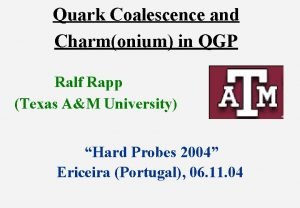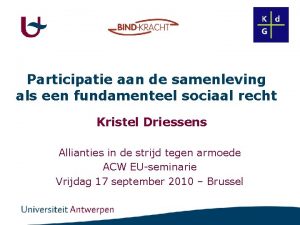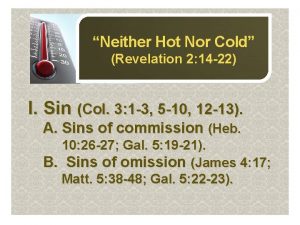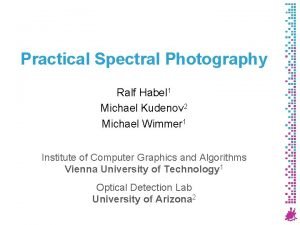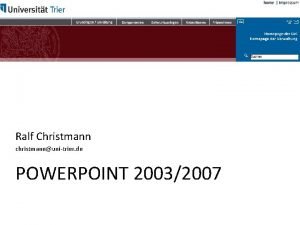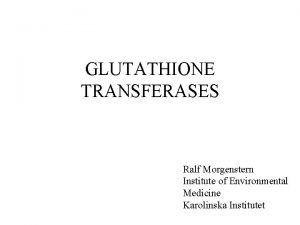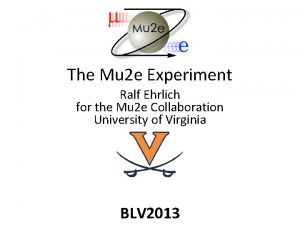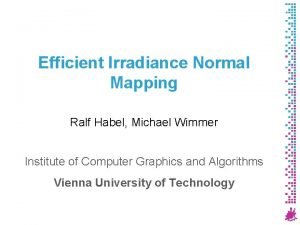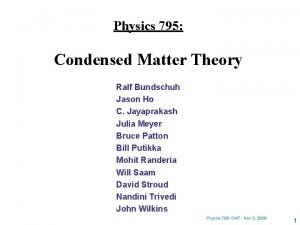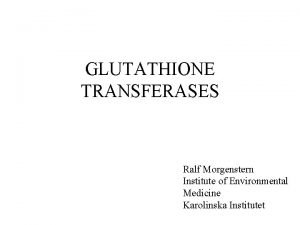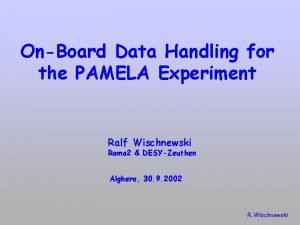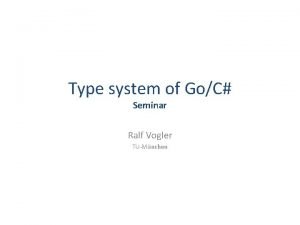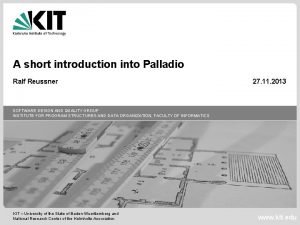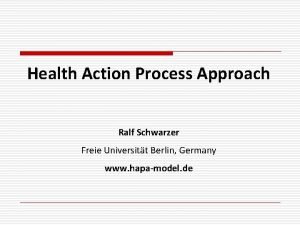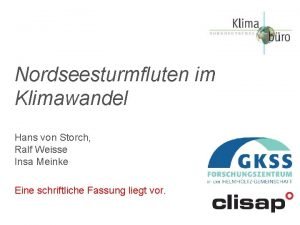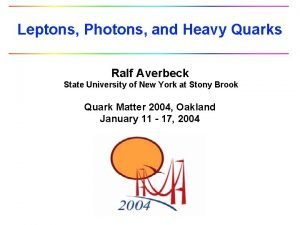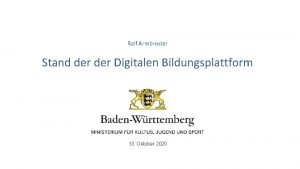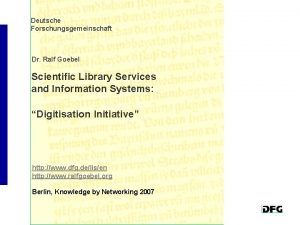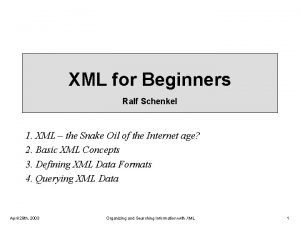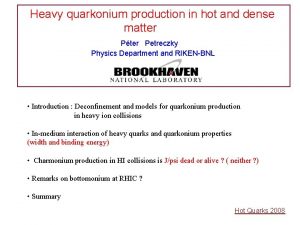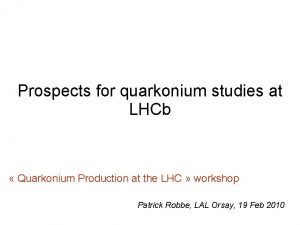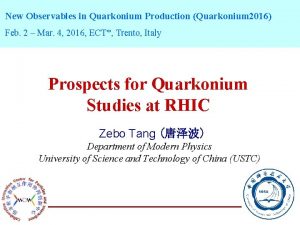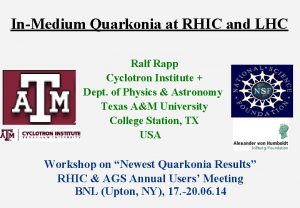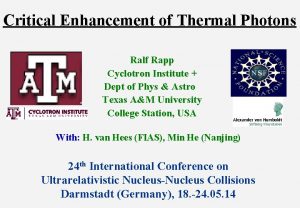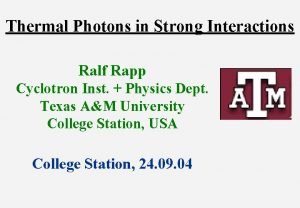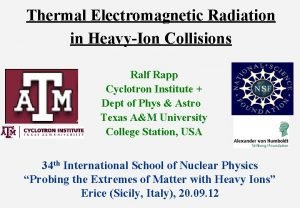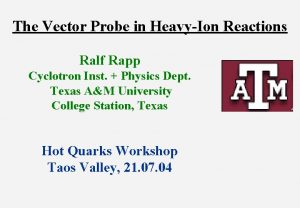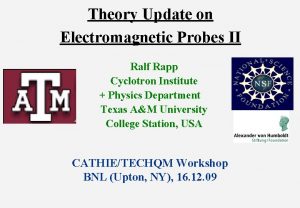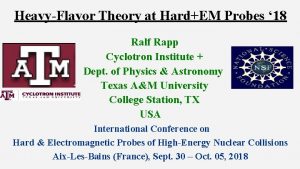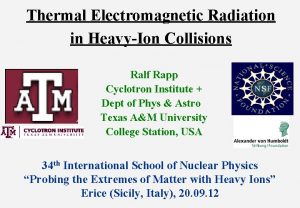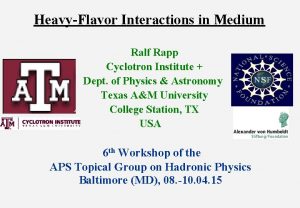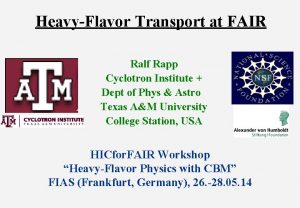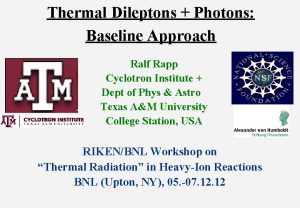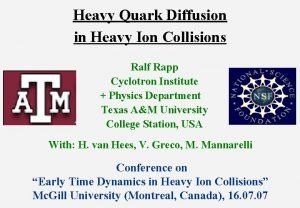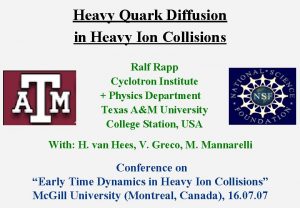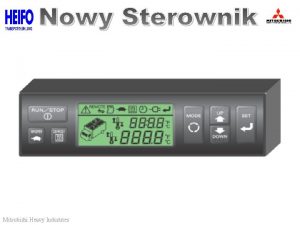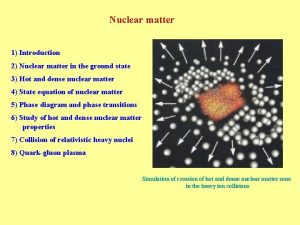Heavy Quarkonium in Hot Nuclear Matter Ralf Rapp
























![4. 2 Charm-Quark T-Matrix + Thermalization Thermal Q-q T-Matrix g [1/fm] Thermalization Rate T 4. 2 Charm-Quark T-Matrix + Thermalization Thermal Q-q T-Matrix g [1/fm] Thermalization Rate T](https://slidetodoc.com/presentation_image_h/b3cbf515a9c4ad071f596f9d6342496e/image-25.jpg)
![4. 3 e± Spectra at RHIC T-mat [van Hees et al ‘ 07] • 4. 3 e± Spectra at RHIC T-mat [van Hees et al ‘ 07] •](https://slidetodoc.com/presentation_image_h/b3cbf515a9c4ad071f596f9d6342496e/image-26.jpg)





![g [1/fm] 4. 3 Thermalization Rate and Diffusion Coefficient T [Ge. V] • Factor g [1/fm] 4. 3 Thermalization Rate and Diffusion Coefficient T [Ge. V] • Factor](https://slidetodoc.com/presentation_image_h/b3cbf515a9c4ad071f596f9d6342496e/image-32.jpg)



![2. 1. 3 In-Medium Charm-Quark Mass in LQCD [Kaczmarek +Zantow ’ 05] [Velytsky et 2. 1. 3 In-Medium Charm-Quark Mass in LQCD [Kaczmarek +Zantow ’ 05] [Velytsky et](https://slidetodoc.com/presentation_image_h/b3cbf515a9c4ad071f596f9d6342496e/image-36.jpg)




- Slides: 40

Heavy Quark/onium in Hot Nuclear Matter Ralf Rapp Cyclotron Institute + Physics Department Texas A&M University College Station, USA INT Program (Week 7) on “Quantifying the Properties of Hot QCD Matter” INT (Seattle), 06. -09. 07. 10

1. ) Introduction: Virtues of Heavy Quarks (c, b) • “Large” scale m. Q >> LQCD , T - factorization in production; thermal medium: pth 2 ~ 2 m. Q T >> T 2 • Interactions spacelike (“low” pt): - quarkonium: potential QCD - heavy-quark diffusion: Brownian motion Q Q → unified framework • Beyond perturbation theory (as expansion) → resummations, bound + scattering states • Constraints essential (lat. QCD, p. QCD, vacuum spectrum, …) • Heavy-ion collisions: - “initial-state” effects - medium effects: equilibrium properties, expansion collectivity

1. 2 Charm/onium Suppression at SPS + RHIC Anomalous J/y Suppression Heavy-Quark Suppression+Flow • Same force operative for quarkonium (un)binding + heavy-quark transport?

1. ) Introduction Outline 2. ) T-Matrix for Heavy Quark/onium in QGP Vacuum Spectroscopy, In-Medium Potentials Spectral + Correlation Functions 3. ) Quarkonia in Heavy-Ion Collisions Thermal Rate Equation Suppression vs. Regeneration 4. ) Heavy-Quark Diffusion in QGP Fokker-Planck + Thermalization Observables at RHIC 5. ) Conclusions

2. ) Heavy-Quark Potential + Thermal T-Matrix • HQ potential well established in vacuum (EFT, lattice, spectroscopy) • Quark-Gluon Plasma: bound+scattering states (quarkonia + HQ transport) • Lippmann-Schwinger equation [Mannarelli+RR ’ 05, Cabrera+RR ’ 06, Riek+RR ‘ 09] In-Medium Q-Q T-Matrix: - Q-Q propagator: - importance of threshold effects • 2 -body potential VL at finite temperature?

2. 2 Heavy-Quark Free Energy in Lattice QCD F 1(r, T) = U 1(r, T) – T S 1(r, T) • Potential “Choices” : (a) Free energy F 1 => weak potential, e. B(1. 1 Tc) ~ 50 Me. V Dm. Q(T) ~ F 1(r=∞, T) small (b) Internal Energy U 1 ( U = ‹Hint› ) => strong potential, e. B(1. 1 Tc) ~ 500 Me. V Dm. Q(T) ~ U 1(r=∞, T) large • approximate compensation in bound-state mass: Ey = 2 mc 0 + 2 Dm. Q - e. B • need improved ways to extract HQ potential [Kaczmarek+Zantow ’ 05]

2. 3 Corrections to Heavy-Quark Potential • Relativistic effects - kinematics - magnetic interaction → “Breit” correction: [Brown et al ‘ 52, ‘ 05] VQ 1 Q 2(r) → VQ 1 Q 2(r) ( 1 – v 1 · v 2 ) (↔ Poincaré-invariance, p. QCD) • Retardation effects - 4 -D → 3 -D reduction of Bethe-Salpeter equation - energy transfer fixed (q 0=0), off-shell behavior ambiguous • Gauge dependence of color-singlet free energy [Philipsen ‘ 08] • Field-theoretic ansatz: [Megias et al ‘ 07] color-Coulomb: vector , string: - fit color-average free energy to lat. QCD implement into “extended T-Matrix approach” scalar [Riek+RR ‘ 10]

2. 3. 2 Temperature Dependence of Fit Parameters In-Medium HQ Free Energies Model Parameters • as ~ 0. 3 • screening of color-Coulomb + string term • “Debye masses” ~ T

2. 4. 1 Constraints I: Vacuum Spectroscopy Quarkonia D-Mesons • no hyperfine splitting • (bare) masses adjusted to ground state • ~ ± 50 Me. V accuracy

2. 4. 2 Constraints II: High-Energy Q-q Scattering Born Approximation compared to Perturbative QCD • Breit correction essential

2. 5 Quarkonium Spectral Functions in Medium 2. 5. 1 Lattice-QCD Correlators • direct computation of Euclidean Correlation Fct. spectral function [Datta et al ‘ 04] hc J/y [Asakawa et al ’ 03, Iida et al ’ 06, Aarts et al ‘ 07, Jakovac et al ‘ 07] • ~20% variation for S-wave charmonia ~ 0. 9 -3 Tc • Bound states survive above Tc? !

2. 5. 2 T-Matrix Spectral Functions with Potential U Euclidean Correlator Ratio S-Wave Spectral Function (narrow-width limit) • S-wave ground state “melts” at Tdiss ≈ 2 Tc • correlator ratios within 30% (3 D reduction scheme)

2. 5. 3 T-Matrix Spectral Functions with Potential F S-Wave Spectral Function Euclidean Correlator Ratio • S-wave ground state “melts” at Tdiss ≈ 1. 3 Tc • reduced c-c- threshold → low-energy strength [Cabrera+RR ’ 06, Riek+RR ‘ 09]

2. 5. 4 Importance of Confining Force J/y Υ

2. 6 Charmonium Widths in QGP q q → sensitive to binding energy (i. e. , color screening) J/y Dissociation Rates S-Wave Spectral Function J/y as~0. 25 • J/y lifetime ~ 1 -4 fm/c [Grandchamp+RR ’ 01] Gymed=200 Me. V • accelerates “melting”: Tdiss ≈ 1. 6 Tc • correlator ratio temperature-stable

2. 6. 2 Momentum Dependence of Inelastic Width • dashed lines: gluo-dissociation • solid lines: quasifree dissociation q q _ • similar to full NLO calculation [Zhao+RR ‘ 07] [Park et al ‘ 07]

2. 6. 3 Relation of Quarkonium Widths to EFT • Singlet-octet transition • Landau damping q q

3. ) Quarkonium Production in URHICs • Regeneration in QGP + HG: - detailed balance reaction rate (y -width) [PBM et al ’ 01, Gorenstein et al ’ 02, Thews et al ’ 01, Grandchamp+RR ’ 01, Ko et al ’ 02, Cassing et al ’ 03, Zhuang et al ’ 05, …] → c + c- + X J/y + g ← equilibrium limit D D J/y c- c J/y • Input from Thermodynamic T-Matrix (weak/strong binding) Gy mc * e By

3. 1 Inputs and Parameters • Input - J/y (cc, y’), c-c- production cross sections [p-p data [PHENIX] ] - “Cold Nuclear Matter”: shadowing, nuclear absorption, pt broadening [p-A data] - Thermal fireball evolution: thermalization time (↔ initial T 0), expansion rate, lifetime, Tc , freezeout … [hadron data, hydrodynamics] • Parameters - strong coupling as controls Gdiss - schematic relaxation for c-quark equilibration: Nyeq (t)~ Nytherm(t) · [1 -exp(-t/tceq)] _

3. 2 Centrality Dependence of J/y at SPS + RHIC Strong-Binding Scenario (U) Weak-Binding Scenario (F) [Zhao+RR in prep] • regeneration controlled by c-quark relaxation time (tceq = 6 vs. 3 fm/c) • similar total yield, but different composition

3. 3 p. T-Dependence of J/y at SPS + RHIC Strong Binding (U) Weak Binding (F) • weak binding problematic with pt-dependence? !

3. 3. 2 p. T-Dependence II: Blast Wave at RHIC Regeneration only (Stat. Model) Rate-Equation (strong bind. ) Au-Au 200 AGe. V [Andronic et al. ‘ 07] • blast wave at ~Tc too soft? • lever arm for direct prod. at high p. T?

3. 3. 3 Charm-Quark p. T-Spectra and Regeneration • microscopic calculation of gain term c + c- + g → J/y + g • supports sensitivity to thermal relaxation time of c quarks

4. ) Heavy-Quark Diffusion in the QGP Q • Brownian Motion: Fokker Planck Eq. [Svetitsky ’ 88, …] thermalization rate • p. QCD elastic scattering: g -1 = ttherm ≥ 20 fm/c slow q, g c diffusion coefficient [Svetitsky ’ 88, Mustafa et al ’ 98, Molnar et al ’ 04, Zhang et al ’ 04, Hees+RR ’ 04, Teaney+Moore ’ 04, Peshier, Gossiaux+Aichelin ‘ 09] • In-medium heavy-light T-matrix: direct connection to quarkonia! [van Hees et al ’ 07, Riek+RR ‘ 10]
![4 2 CharmQuark TMatrix Thermalization Thermal Qq TMatrix g 1fm Thermalization Rate T 4. 2 Charm-Quark T-Matrix + Thermalization Thermal Q-q T-Matrix g [1/fm] Thermalization Rate T](https://slidetodoc.com/presentation_image_h/b3cbf515a9c4ad071f596f9d6342496e/image-25.jpg)
4. 2 Charm-Quark T-Matrix + Thermalization Thermal Q-q T-Matrix g [1/fm] Thermalization Rate T [Ge. V] • meson/diquark resonances for T < 1. 5 Tc • factor 3 -4 (~2) larger than pert. QCD for U (F) potential [Riek+RR ‘ 10]
![4 3 e Spectra at RHIC Tmat van Hees et al 07 4. 3 e± Spectra at RHIC T-mat [van Hees et al ‘ 07] •](https://slidetodoc.com/presentation_image_h/b3cbf515a9c4ad071f596f9d6342496e/image-26.jpg)
4. 3 e± Spectra at RHIC T-mat [van Hees et al ‘ 07] • hadronic resonances at ~Tc ↔ quark coalescence • connects 2 “pillars” of RHIC: strong coupl. + coalescence

5. ) Conclusions • Thermodynamic T-matrix for heavy quarks + quarkonia - vacuum: spectroscopy + p. QCD limit - in-medium potential from lattice QCD? U 1 (Tdy~2 Tc) , F 1 (Tdy~1. 3 Tc) , or else … - confining force mandatory for realistic calculations • Quarkonium phenomenology - “strong” vs. “weak” J/y binding (pt-data, lever arm, …) - bottomonium suppression? (less regeneration …) • Open heavy flavor - resonances close to Tc ? (strong coupling + coalescence …) - RHIC non-photonic e± Ds (2 p. T) ≈ 5 - scrutinize medium evolution, Fokker-Planck, d-Au …

3. 2. 3 Rapidity Dependence at RHIC Thermal Rate-Eq Approach • regeneration yield sensitive to d. Nc/dy • hot matter effects insufficient • additional shadowing at forward y (assuming constant sabs) [Kharzeev et al. ‘ 07, Ferreiro et al. ‘ 08] [Zhao+RR in prep]

3. 2. 5 Momentum Spectra Au-Au 200 AGe. V • regeneration part → blast-wave at Tc • regeneration at low p. T • high p. T: formation time ( bottom feeddown, … [Zhao+RR ’ 07, ‘ 08] ), [Karsch+Petronzio ’ 87, Blaizot+Ollitrault ‘ 87]

3. 2. 4 Momentum Spectra and Elliptic Flow • regeneration at low pt → small v 2 • direct component at high pt → small v 2 [Zhao+RR ’ 08, Zhuang et al ‘ 06]

2. 4. 2 Example from “Extended T-Matrix Model” S-Wave Spectral Function hc • cc- propagator with Gc= 100 Me. V: • S-wave “melting” Tdiss ≈ 1. 5 -2 Tc • correlator ratio temperature-stable Euclidean Correlator Ratio
![g 1fm 4 3 Thermalization Rate and Diffusion Coefficient T Ge V Factor g [1/fm] 4. 3 Thermalization Rate and Diffusion Coefficient T [Ge. V] • Factor](https://slidetodoc.com/presentation_image_h/b3cbf515a9c4ad071f596f9d6342496e/image-32.jpg)
g [1/fm] 4. 3 Thermalization Rate and Diffusion Coefficient T [Ge. V] • Factor ~3 -4 larger thermalization rates than in pert. QCD • “different” approaches related, e. g. Ad. S/CFT ↔ Coulomb

2. 4 Mesonic Spectral Functions + Correlators • Euclidean Correlation Function (precise lat-QCD data avail. !) Correlator Ratio:

2. 2. 2 Potential Models in the QGP ~F 1 potential [Mocsy+ Petreczky ’ 05, ‘ 08] U 1 potential [Cabrera +RR ‘ 06] hc mcc=1. 7 Ge. V mc * • F 1 low threshold (2 mc~ 2. 7 Ge. V), ground state Tdiss ~ 1. 2 Tc • U 1 decreasing threshold and e. B, Tdiss ~2. 5 Tc both scenarios compatible with lat-QCD

3. 1. 3 Equilibrium Limit (Statistical Model) • fixed c-c- number: • equilibrium Y number: • (very) sensitive to open-charm spectrum [Grandchamp et al ’ 03, Andronic et al ’ 07, …] • thermal relaxation for c-quark spectra:
![2 1 3 InMedium CharmQuark Mass in LQCD Kaczmarek Zantow 05 Velytsky et 2. 1. 3 In-Medium Charm-Quark Mass in LQCD [Kaczmarek +Zantow ’ 05] [Velytsky et](https://slidetodoc.com/presentation_image_h/b3cbf515a9c4ad071f596f9d6342496e/image-36.jpg)
2. 1. 3 In-Medium Charm-Quark Mass in LQCD [Kaczmarek +Zantow ’ 05] [Velytsky et al ’ 09] F • U : large variation close to Tc – mass interpretation? ! • fit quark-number fluctuations with zero-width quasiparticle model c(T) ~ ∂2 P / ∂2 mc

3. 3. 4 Rapidity Dependence at RHIC Statistical Model • reproduced in statistical hadronization model (GC ensemble) [Andronic et al. ’ 07] • more problematic in dynamic approaches [Capella et al. ’ 07, Zhao+RR ‘ 08] • additional shadowing at forward y? [Kharzeev et al. ‘ 07, Ferreiro et al. ‘ 08] Thermal Rate-Eq Approach

3. 4 Upsilon at RHIC No Color-Debye Screening With Color-Debye Screening [Grandchamp et al. ’ 05] • (1 S, 2 S) suppression unambiguous QGP signature ? ! • NB: 50% feed-down on (1 S)

3. 3 Heavy-Quark Spectra at RHIC • relativistic Langevin simulation in elliptic expanding fireball background Nuclear Modification Factor Elliptic Flow p. T [Ge. V] • T-matrix approach ≈ effective resonance model • similar to “coll. dissoc. ” [Adil+Vitev ’ 07]; radiative E-loss? (2↔ 3), …

2. 3. 2 Bottomonium Reaction Rates in QGP • color-screening accelerates dissociation • significance at RHIC: t. Y ≈ 50 → 5 fm/c [Grandchamp et al. ’ 05]
 Ralf rapp
Ralf rapp Ratey algebra 2
Ratey algebra 2 Geoglam rapp
Geoglam rapp Krachtenmodel van rapp
Krachtenmodel van rapp Rapp method
Rapp method Rapp method
Rapp method Fisión nuclear vs fision nuclear
Fisión nuclear vs fision nuclear Lesson 15 nuclear quest nuclear reactions
Lesson 15 nuclear quest nuclear reactions Hot nor hot
Hot nor hot White hot vs red hot temperature
White hot vs red hot temperature Hot working of metal is
Hot working of metal is Perbedaan hot lava dan hot lava volcano
Perbedaan hot lava dan hot lava volcano Städtereisen ito
Städtereisen ito Urlaub ito
Urlaub ito Ralf habel
Ralf habel Powerpoint entwurfsvorlagen
Powerpoint entwurfsvorlagen Aigiki
Aigiki Ralf ehrlich
Ralf ehrlich Ralf habel
Ralf habel Ralf bundschuh
Ralf bundschuh H
H Pamela ralf
Pamela ralf Ralf vogler
Ralf vogler Ralf reussner
Ralf reussner Dr. ralf kirchhoff
Dr. ralf kirchhoff Health action process approach
Health action process approach Ralf weiße
Ralf weiße Ralf bendrath
Ralf bendrath Ralf averbeck
Ralf averbeck Ralf armbruster
Ralf armbruster Dr. ralf goebel
Dr. ralf goebel Ralf schenkel
Ralf schenkel Entstrukturierungsthese
Entstrukturierungsthese Ralf kronawitter
Ralf kronawitter Ralf behnke
Ralf behnke Flow of energy vs flow of matter
Flow of energy vs flow of matter White matter of brain
White matter of brain Section 1 composition of matter chapter 15 answer key
Section 1 composition of matter chapter 15 answer key Composition of matter section 1
Composition of matter section 1 Gray matter and white matter
Gray matter and white matter Chapter 2 matter section 1 classifying matter answer key
Chapter 2 matter section 1 classifying matter answer key
